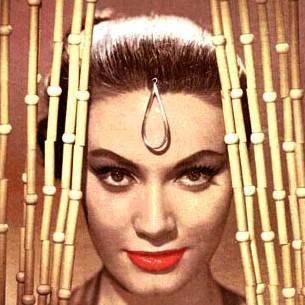
Exotica
Les Baxter's album Ritual of the Savage (Le Sacre du Sauvage) was released in 1952 and would become a cornerstone of exotica.[3] This album featured lush orchestral arrangements along with tribal rhythms and offered such classics as "Quiet Village", "Jungle River Boat", "Love Dance", and "Stone God." Ritual is the seminal Exotica record, influencing all that came after it. As the 1950s progressed, Baxter carved out a niche in this area, producing a number of titles in this style including "Tamboo!" (1956), "Caribbean Moonlight" (1956), "Ports of Pleasure" (1957), and "The Sacred Idol" (1960). Baxter claimed Ravel and Stravinsky as influences on his work.[4]\r \r In 1957, Martin Denny covered Les Baxter's "Quiet Village", with exotic bird calls and a vibraphone instead of strings, which established the sound of the Polynesian styled music. The song reached #2 on Billboard's charts in 1959 with Denny's Exotica album reaching #1.[5] Soon the new technology of stereo further opened up the musical palettes of Denny and other prominent exotica artists such as Arthur Lyman and Juan García Esquivel.\r \r The distinctive sound of exotica relies on a variety of instruments: conga, bongos, vibes, Indonesian and Burmese gongs, boo bams (bamboo sticks), Tahitian log, Chinese bell tree and Japanese kotos. Additionally intrinsic to the sound of exotica are bird calls, big-cat roars, and even primate shrieks which invoke the dangers of the jungle. Though there are some standards which contain lyrics, singing is rare. Abstract, sirenish ululations, chants, vocalized animal calls, and guttural growls are common.[1][5]\r \r The music of American composer Raymond Scott is sometimes recognized as a precursor to exotica, as several of his songs were written with the intent of transporting the listener to exotic locations via novelty instruments and sound effects.\r \r As a result of the popularity of exotica during the late 1950s, a large number of records were released that featured covers of recently-released exotica songs (mainly by Les Baxter) and Hawaiian and easy-listening standards. These recordings include "Exotica" by Ted Auletta, "Exotic Percussion" by Stanley Black and his Orchestra, "Orienta" by Gerald Fried, "Taboo" and "Taboo 2" by Arthur Lyman and "The Sounds of Exotic Island" by The Surfmen. However, some composers pushed the bounds of the genre by producing albums of original content, often with unusual instrumentation. These recordings include "Voodoo" by Robert Drasnin, "Africana" by Chaino, "Pagan Festival" by Dominic Frontiere And His Orchestra, and "White Goddess" by Frank Hunter. By 1959, the majority of American record labels from majors such as Columbia, RCA, Warner Brothers and United Artists to "budget" labels such as Kapp, Crown, Dot, and Roulette had released at least one exotica-themed album, usually utilizing composers and musicians that produced jazz, classical or easy-listening recordings.\r \r After several years of success, as the 1950s Hawaiiana fad waned in the United States, so did exotica's commercial appeal.
